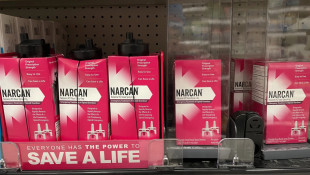
Veterinary staff performs surgery at the University of Missouri Veterinary Medical Center on Sept. 1, 2023. At the medical center, attending veterinarians work alongside veterinary students as they move through their clinical rotations. Vet techs and assistants also work at the veterinary medical center, where students spend the last two years of their training.
Anna Spidel / KBIA
By Anna Spidel - Side Effects Public Media
If you or someone you know is in crisis, please call, text or chat with the Suicide and Crisis Lifeline at 988, or contact the Crisis Text Line by texting TALK to 741741.
The white noise machine in psychologist Kerry Karaffa’s office is one way to ensure privacy when he counsels veterinary students on campus. Karaffa is an embedded psychologist at the University of Missouri College of Veterinary Medicine who also studies mental health in the field.
“If you hear a news story, and you hear like, ‘Oh, wow, there are elevated rates of all these mental health problems or suicide,’ and it's not presented in context, it gives the message that every veterinarian is struggling,” Karaffa said. “Or if you go into vet med, you will be unhappy. And that's not the case at all.”
He said that veterinarians largely find satisfaction doing their job, but there are also many challenges. And the importance of his role can’t be overstated. Veterinarians are between two to four times more likely to die by suicide than the general population, according to a 2019 study. Karaffa said there are some inaccurate assumptions around potential driving factors behind these high suicide rates.
“People have a tendency to get rather reductionistic,” Karaffa said. “We want answers, we want to know ‘A plus B equals C.' But the truth is there's a host of factors that can play into it.”
Veterinary students often struggle with perfectionism, which can lead to high levels of stress and anxiety. Meghan Lawlor, a third year student, has experienced this firsthand. She has recently received her white coat and began clinical rotations this fall.
She started seeing Karaffa during her first year, which has helped her through a tough time.
“Even as a pre-veterinary student you're kind of groomed to be a perfectionist, and that I think carries through the whole profession. As a veterinary student, you're striving to still get the best grades and be a president of all these clubs,” Lawlor said. “And then again, it carries on into being a practicing veterinary professional, where…you're not only a caretaker for people's pets, but also their counselor.”

Veterinarians –– much like pediatricians –– treat patients who cannot fully communicate how they feel or what hurts. They also have to attend to worried parents who need answers. This can all add to the stress. Long working hours and having to make tough moral decisions are also big factors, said Taylor Miller, a mental health advocate with the nonprofit Not One More Vet.
“Each veterinarian serves so many masters. In most cases, it's impossible to make the correct decision because you cannot please yourself from a moral standpoint,” Miller said. “You cannot take care of the pet, satisfy the client's expectations, have your priorities align with your clinic's priorities and your colleagues’ dictates, and satisfy the public all at once with every decision.”
Performing euthanasia is part of many veterinarians’ jobs and studies show that it can have a psychological impact on a person. Karaffa said some people think that it is a main contributor to the high suicide rates in the field, but this correlation is not supported by evidence.
Miller, who was a practicing veterinarian and is now a mental health counselor, said she doesn’t enjoy losing animals or causing death. But, she added, when performing euthanasia, it felt like she and her clients’ priorities were “aligned” and that she was “doing the right thing” for the pets.
“Consistently in practice, despite the grief of a euthanasia, I often found my euthanasia appointments to be the most rewarding,” Miller said. “I could make a terrible moment as positive as possible.”
While studies suggest that performing procedure itself does not directly contribute to the high rates of suicide, access to the drugs used to perform euthanasia does.
According to one study, poisoning was the most common mechanism of death among veterinary professionals who died by suicide or in a manner undetermined. A drug called pentobarbital, which is a medication routinely used for euthanasia in veterinary practice, was used in 25% of the cases of poisoning among veterinarians. Most of these poisoning deaths occurred at home.
Studies also showed that when excluding suicides with the euthanasia solution from the data, the rate of suicide among veterinarians was not significantly different from the general population.
Karaffa said this is an important factor to consider, and it opens up the possibility for discussions around changing access.
Some argue that limiting access to lethal means will simply lead people to look for another suicide method. But research suggests that limiting access is an effective method for reducing suicides overall, not just the number of suicides in which those means were used. This, however, does not suggest the need to remove all access to euthanasia solutions, which is an important part of a veterinarian's job. Simply making access more difficult may be sufficient, according to one study.
“For instance, placing barriers on bridges has been shown to reduce suicide from jumping, and requiring individuals to purchase charcoal behind a pharmacy counter rather than from open shelves resulted in an overall reduction in suicide in an area of Hong Kong where charcoal asphyxiation had become a frequently used suicide method,” the study authors said.
Mental health experts say there is a need to have open discussions in the veterinary field about the root causes of mental health stress as well as solutions to help those who are in crisis.
“Whenever I talk about these issues, I always want to emphasize that they're very, very serious, and we have to be doing something. And I feel like we also have to be focusing on tangible kinds of solutions,” Karaffa said.

Suzanne Tomasi, an epidemiologist at the Centers for Disease Control and Prevention’s National Institute for Occupational Health and Safety, said those conversations are happening, but finding “tangible” solutions can be a real challenge.
“In the profession, when you bring this topic up they kind of stop talking about it, because they're like, ‘Well, in my situation we can't do that because of XYZ,’” Tomasi said.
Tomasi, who used to be a practicing veterinarian, said that some proposed solutions include putting stickers with crisis hotline numbers inside of drug lock boxes, or implementing a two-person system of accessing the drugs. But, she said much of the pushback against controlling access to drugs has to do with concerns about how quickly a practitioner can get to them in case of a clinical emergency.
“In my mind, I couldn't think of any scenario I had ever been in, in clinical medicine where I needed access to euthanasia solution quickly,” Tomasi said.
It can get complicated to apply broad solutions to a field that varies so widely, she said. Unlike human medicine, veterinarians don’t rely on pharmacists to dispense medications - they essentially are the pharmacists. And while many veterinary professionals work in hospitals that have large numbers of personnel, some veterinarians run their own practices and don’t work with anyone else but themselves. According to Tomasi, this is one area where problems can arise with implementing a two-person system.
“The large animal vets that are in a truck by themselves, they don't have somebody else with them,” Tomasi said. “So who's going to sign off?”
She believes it’s important to focus on cultural contributors like occupational stress, burnout and perfectionism, but she said that it’s still crucial to consider access to lethal means for those who are already experiencing a crisis.
“The big profession changes are going to come slow,” Tomasi said. “And so the thought with the access is - this will maybe save those people that are in those dark moments now, long enough to allow the big picture changes to help them.”
If you or someone you know is in crisis, please call, text or chat with the Suicide and Crisis Lifeline at 988, or contact the Crisis Text Line by texting TALK to 741741.
Side Effects Public Media is a health reporting collaboration based at WFYI in Indianapolis. We partner with NPR stations across the Midwest and surrounding areas — including KBIA and KCUR in Missouri, Iowa Public Radio, Ideastream in Ohio and WFPL in Kentucky.
9(MDAyMzk1MzA4MDE2MjY3OTY1MjM5ZDJjYQ000))
 DONATE
DONATE






 View More Articles
View More Articles


 Support WFYI. We can't do it without you.
Support WFYI. We can't do it without you.